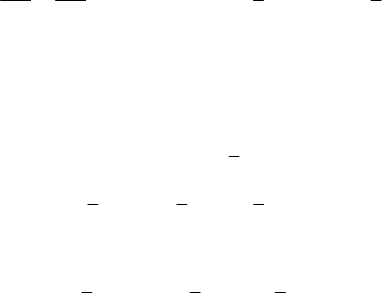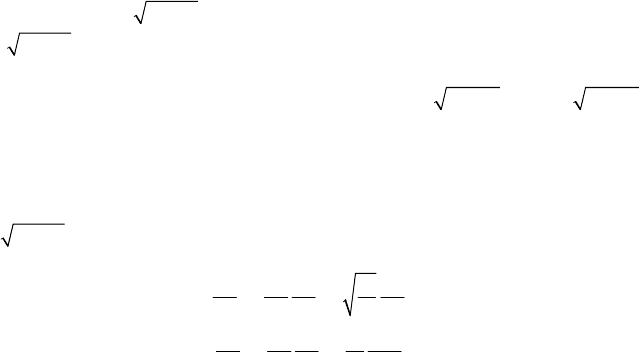Teodorescu P.P. Mechanical Systems, Volume III: Analytical Mechanics
Подождите немного. Документ загружается.


MECHANICAL SYSTEMS, CLASSICAL MODELS
602
++= =( ), 1,2,...,
ij j ij j ij j i
aq cq bq Q t i s ;
(23.2.71)
in a matric form, we can write
++=Aq Cq Bq Q
.
(23.2.71')
The general solution is given by
∗∗
=
=+= +
∑
qq q a q
2
0
1
e
k
s
t
kk
k
C
λ
,
(23.2.71'')
where
q
0
is the general solution of the homogeneous equation, while
∗
q is a particular
solution of the complete equation. We assume that the origin (
====
12
... 0
s
qq q )
represents an asymptotically stable position of equilibrium, so that
Re 0, 1,2,...,2
k
ksλ <= ; hence, →q
0
0 for →∞t , so that, for a sufficient long
time
t , one can neglect q
0
with respect to
∗
q . In what follows we make a study of the
particular solution
∗
q .
We assume that only one component of the generalized force
Q is non-zero, let be
1
( ) 0, ( ) 0, 2,3,...,
j
Qt Qt j s≠==; because the system is linear, we can obtain a
general result by superposition of effects. Choosing the non-zero component of the
generalized force in the form
=
i
1
() e
t
Qt A
ω
, the system (23.2.71) will be given by
++=
++==
i
111
e,
0, 2,3,..., .
t
jjj
jjj
ij j ij j ij j
aq cq bq A
aq cq bq i s
ω
We search a solution of the form
==
i
e , 1,2,...,
t
jj
qa j s
ω
,
the amplitude
j
a
being given by the system of algebraic equations
++=
⎡⎤
⎣⎦
++==
⎡⎤
⎣⎦
2
111
2
(i ) (i ) ,
(i ) (i ) 0, 2, 3,..., ;
j
jjj
ij ij ij j
acbaA
acbai s
ωω
ωω
(23.2.72)
the solution of this system is
==
1
(i ) , 1,2,...,
j
j
aW Aj sω ,
(23.2.72')
where
Δ
==
Δ
1
1
(i )
(i ) , 1,2,...,
(i )
j
j
Wjs
ω
ω
ω
,
(23.2.72'')

Stability and Vibrations
603
is a function in the form of a rational fraction with real coefficients, depending on
iω ;
the hodograph of this function in the complex plane (or even the function itself) is
called the characteristic frequency or the characteristic amplitude-phase.
Let us write the characteristic frequency in the form
==
1
i()
11
(i ) ( )e , 1,2,...,
j
jj
WR j s
ψω
ωω ,
(23.2.72''')
where
>
1
() 0
j
R ω
is the characteristic amplitude, while
1
()
j
ψω
is the characteristic
phase; finally, it results
+
==
1
i[ ( )]
1
( ) ( ) e , 1,2,...,
j
t
j
j
qt R A j s
ωψ ω
ω
.
(23.2.73)
If we choose now the non-zero component of the generalized force in the form
=
1
() cosQt A tω , we get, analogously,
()
=+=
11
( ) ( ) cos ( ) , 1,2,...,
j
jj
qt R A t j sωωψω .
(23.2.73')
We remark that, passing from the generalized force
1
()Qt to the generalized
co-ordinate
()
j
qt
, we amplify the amplitude by the characteristic amplitude and shift
the phase by the characteristic phase
1
()
j
ψω for = 1,2,...,
j
s . We can thus state that
1
()
j
R ω increases or decreases the amplitude of the perturbing force; the filter principle
is based on this observation.
23.2.2.4 Action of Small Dissipative Forces Upon a Conservative, Holonomic and
Scleronomic Discrete Mechanical System
Let us suppose that the matrices =B []
ij
b and =C []
ij
c which intervene in the
expression (23.2.68) of the generalized forces are symmetric and positive definite.
Introducing the potential energy and Rayleigh’s dissipative function (see Sect. 23.2.1.13
too), we can write
∂∂
=− − = = =
∂∂
11
, 1,2,..., , ,
22
jijijijij
jj
VR
QjsVbqqRcqq
qq
.
(23.2.74)
The dissipative forces do not change the stability of the position of equilibrium;
moreover, in some cases, this position can be asymptotically stable.
To integrate the equation of motion (23.2.67''), we search a solution of the form
(23.2.68); the amplitudes
=,1,2,...,
j
aj s, will be given by the algebraic system
(23.2.69'). Multiplying by the amplitudes
i
a , complex conjugate to
i
a , we obtain
++=
2
0
ij i j ij i j ij i j
aaa caa baaλλ ,
(23.2.75)
or, in compact notation,
2
(, ) (, ) (, ) 0ACBλ ++=aa aa aa ,
(23.2.75')

MECHANICAL SYSTEMS, CLASSICAL MODELS
604
where we have used the bilinear form (23.2.10); we notice that
( , ) 0, ( , ) 0, ( , ) 0ABC>>>aa aa aa , so that <Re 0λ . Let i,λγδ=+
iλγδ=− be two complex conjugate roots of the secular equation (23.2.70); we
notice that these roots verify the equation (23.2.75') too. Denoting
i, i=+ =−auvauv, where
u
and
v
are real column vectors, we can write
2
(, ) (, ) (, )
2Re 0,
(, ) (, ) (, )
(, ) (, ) (, )
0,
(, ) (, ) (, )
CCC
AAA
BBB
AAA
λλλ
λλλ
+
=+=− =− <
+
+
== = >
+
aa uu vv
aa uu vv
aa uu vv
aa uu vv
(23.2.75'')
where we have used the property (iv) in Sect. 23.2.1.2. Hence, to two complex conjugate
roots
λ and λ correspond two complex conjugate oscillations ae
tλ
and ae
tλ
. Taking
two complex conjugate constants
=+(1/ 2)( i)C αβ, =−(1/2)( i)C αβ, we may
write
()()
[]
+= − −+aa uv vueee cos sin
ttt
CC t t
λλγ
αβ δ αβ δ.
(23.2.75''')
If to the real roots
λ and
′
λ correspond the column vectors a and
′
a , respectively,
we obtain, analogously, the equation
2
(, ) (, ) (, ) 0ACBλ
′′′
++=
aa aa aa ,
(23.2.76)
wherefrom
(, ) (, )
,
(, ) (, )
CB
AA
λλ λλ
′′
+=− =
′′
aa aa
aa aa
.
(23.2.76')
Passing to normal co-ordinates, we can express the kinetic and the potential energy,
respectively, in the form (23.2.3'''); Rayleigh’s dissipative function will be given by
===
′′′
=+
∑∑∑
2
111
11
22
sss
ii ijij
iij
Rq qqββ,
(23.2.77)
where we assume that the coefficients
0, , , , 1,2,...,
iij
ijij sββ>≠=, are small
(the product and the squares of these coefficients are negligible). We obtain Lagrange’s
equations
=
′′
++ ==
∑
1
0, 1,2,...,
s
iii ijj
j
qq q i sββ ;
(23.2.78)
searching solutions of the form
e , 1,2,...,
t
ii
qis
λ
α
′
==
, we get the system of linear
algebraic equations

Stability and Vibrations
605
()
=
++ + =≠=
∑
22
1
0, , 1,2,...,
s
iii ijj
j
iji sλβλωαλβα .
(23.2.78')
To have non-trivial solutions, one must equate to zero the determinant of the
coefficients; it results the characteristic equation
++
++
=
++
22
11 12 1
22
21 2 2 2
22
12
...
...
0
... ... ... ...
...
s
s
ss
ss
λβλω βλ βλ
βλ λ βλ ω βλ
βλ βλ λ βλ ω
.
(23.2.79)
Developing the determinant and neglecting the product of coefficients
,
iij
ββ, as it has
been mentioned above, we obtain
()
=
++ =
∏
22
1
0
s
ii
i
λβλω
,
(23.2.79')
so that we can write, with a good approximation,
≅− ± =i , 1,2,...,
2
j
jj
j
s
β
λω
.
(23.2.79'')
Let us consider
=− +
111
(1/2) iλβω and let us calculate the amplitudes
, 1,2,...,
i
isα = . Replacing in the last − 1s equations (23.2.78'), we can write
22
122 3
21 2 1 23 2
11 1 1
22
2133
31 32 3 1 3
1111
i ... 0,
i ... 0,
..............................................................................................
s
s
s
s
ωωα α
α
βββ β β
ωα α α
αωωα
α
ββ ββ β
αωαα
−
⎛⎞
+−+ + ++ =
⎜⎟
⎝⎠
−
⎛⎞
++−+ ++=
⎜⎟
⎝⎠
22
23 1
12 3 1
11 11
... i 0,
s
s
s
ss s
αα ωω
α
ββ β ββ
αα ωα
−
⎛⎞
++++−+ =
⎜⎟
⎝⎠
obtaining a system of
− 1s equations for the ratios
1
/ , 1,2,...,
j
jsαα = ; neglecting
the terms of higher order in
i
β and
ij
β , we obtain
== =
−
11
22
1
1
i , , 2,3,...,
jj
jj
j
js
βω
α
εε
α
ωω
,
(23.2.80)
, 2,3,...,
j
jsε = , being real small quantities, of the same order of magnitude. There
results the normal co-ordinates (we assume that
− i
1
=Ae
α
α )

MECHANICAL SYSTEMS, CLASSICAL MODELS
606
−−
−−+
′
=
′
==
11
11
(/2)i( )
1
(/2)i( /2)
1
() Ae e ,
( ) Ae e , 2, 3,..., .
tt
tt
j
qt
qt j s
βωα
βωαπ
ε
(23.2.80')
Taking into account
11
(1/2) iλβω=− − too, we obtain, by a linear combination,
()
(
)
1
1
(/2)
11
(/2)
1
() Ae cos ,
( ) Ae cos , 2, 3,..., .
2
t
t
jj
qt t
qt t j s
β
β
ωα
π
εωα
−
−
′
=−
′
=−+=
(23.2.80'')
We get analogous expressions for the other principal oscillations.
We notice thus that the dissipative forces do not modify the frequencies of the
conservative discrete mechanical system; the oscillations induced by these forces tend
to zero for
→∞t . In the principal oscillation of order j , all the co-ordinates are small
with respect to the co-ordinate of order
j
and differ in phase from it with a quarter of a
period (
=/2 2 /4ππ).
23.2.3 Non-linear Vibrations
The non-linear vibrations appear in the case of many phenomena of mechanical nature,
their mathematical modelling leading to non-linear differential equations or systems of
differential equations. In general, a differential equation of these vibrations is of the form
+=(,,) 0xfxxt
(23.2.81)
and is obtained from Newton’s equation, which links the elastic forces to the
displacements. In particular, one can consider autonomous vibrations, which lead to
equations of the form
+=(,) 0xfxx
(23.2.81')
or to non-autonomous vibrations of the form
+=(,) 0xfxt
(23.2.81'')
or of the form
+=(,) 0xfxt .
(23.2.81''')
It has been shown in Sect. 8.2.2.13, in some particular cases, how one can obtain
such equations.
As well, it has been put in evidence an exact method to determine the period of
non-damped free non-linear vibrations, establishing the formula (8.2.86).
An important class of non-linear equations is that with small non-linearities (which
are put in evidence by a small parameter) of the form (8.2.88), (8.2.88''), and these
equations will be called quasilinear.

Stability and Vibrations
607
Besides the topological methods of calculation, as S.P. Timoshenko’s method, the
Ostrogradskiĭ-Lyapunov method, the least squares method and the method of the
harmonic balance. One has considered also the method of the equivalent linearization
for a quasilinear equation of the form
++ =
2
0
(,) 0xxfxxωε
and for Van der Pol’s equation
()
+− − = >
2
10,0xx xxλλ ;
we mention also the method of perturbations, initiated by Poincaré and used by Krylov
and Bogoliubov (Krylov, A.N., 1958; Bogoliubov, N. and Mitropolsky, Y., 1961).
We mention also the graphic methods of computation, between them the isoclinal
method and the delta method.
In what follows, we present the method of the variation of constants too; one makes,
as well, some considerations concerning the parametric vibrations and the non-linear
self-vibrations.
23.2.3.1 Parametric Vibrations
The parametric vibrations are vibrations with variable characteristics, hence
vibrations of a discrete mechanical system, the parameters (mass, frequency,
dimensions, elastic coefficient, damping coefficient etc.) of which are functions of time.
Such an equation is, e. g., the equation (8.2.82') of the mathematical pendulum of
variable length
= ()llt.
In the absence of a perturbing force, a mathematical model of such a mechanical
phenomenon leads to a differential equation of the form
++=() () 0xtxtxαβ ,
which – by a certain substitution – leads to the equation
+= =−−
2
11
() 0, () () () ()
24
utu t t t t
γγβαα ,
studied in Sect. 8.2.2.12.
In the following, we consider the equation
[
]
++ = =() 0, , constuabftu ab ,
(23.2.82)
where
()ft is a periodic function of time ( =+() ( )ft ft T). If =() cos2ft tω , then
one obtains Mathieu’s equation (see Sect. 8.2.2.13 too) for a variation of the rigidity in
time.
The general solution of the equation (23.2.82) is of the form

MECHANICAL SYSTEMS, CLASSICAL MODELS
608
=+
11 22
() () ()ut Cu t Cu t ,
(23.2.82')
where
1
()ut and
2
()ut are two linear independent particular solutions of this equation,
while
1
C and
2
C are two arbitrary integration constants. Obviously, we can write
+= ++ +
11 22
() () ()ut T Cu t T Cu t T
too, where
+
1
()ut T and +
2
()ut T are also particular solutions, because ()ft is a
periodic function. Hence,
+= +
+= +
1111122
2211222
( ) () (),
( ) () (),
ut T aut aut
ut T aut aut
where
1
()ut and
2
()ut, as well as ()ut , are functions which – in general – are not
periodic ones.
Let us suppose that
+=()()ut T sut ,
(23.2.82'')
hence, that, after a period, the amplitude of the action is amplified by
s ; let be
> 0s
.
After
n periods, the amplitude is amplified by
n
s . If > 1s , then the amplitude
increases indefinitely, the motion being instable, while if
< 1s , then the amplitude
tends to zero, the motion being stable. Replacing in the formula (23.2.82''), we may
write
[
]
[
]
[
]
+= ++ +
1 1 2 2 1 11 1 12 2 2 21 1 22 2
() () () () () ()sCut Cut C aut aut C aut aut ;
this relation is independent on time if
() ()
−+ = +−=
11 1 21 2 12 1 22 2
0, 0asCaC aC asC .
The constants
1
C and
2
C are non-trivial if the determinant of the coefficients vanishes
−
=
−
11 21
12 22
0
asa
aas
,
(23.2.83)
hence for
s given by
()
−+ + − =
2
11 22 11 22 12 21
0saasaaaa ;
(23.2.83')
if
>
1
||1s or >
2
||1s , then the motion is instable, while if ≤
1
||1s and ≤
2
||1s ,
then the motion is stable. The difficulty of calculation consists in the searching of the
particular solutions
1
()ut and
2
()ut.

Stability and Vibrations
609
23.2.3.2 Method of the Variation of Constants
Let be a discrete mechanical system subjected to non-damped free non-linear
oscillations, which lead to the non-linear equation
++ =(,) 0xx fxxε ,
(23.2.84)
where
ε is a small parameter, the function (, )fxx containing both linear and
non-linear terms in
x and x . Denoting =xy , one obtains the equivalent system
==−−,(,)xyy x fxyε ,
(23.2.84')
the associated linear system of which is (we make
= 0ε )
==−,xyy x,
(23.2.85)
with the solutions
=+ =−+
12 12
cos sin , sin cosxC tC ty C tC t.
(23.2.85')
In the method of variation of constants, we write
=+ =−+
12 12
()cos ()sin, ()sin ()cosxCttCttyCttCtt;
(23.2.85'')
introducing in the non-linear system (23.2.84'), one obtains
()
12
12
1212
()cos ()sin 0,
()sin ()cos
( )cos ( )sin , ( )sin ( )cos .
Ct t Ct t
Ct t Ct t
fCt t Ct tCt t Ct tε
+=
+
=− + − +
Hence, it results
()
()
11 21 2
21212
() ()cos ()sin, ()sin ()cos sin,
() ()cos ()sin, ()sin ()cos cos;
Ct fCttCttCttCttt
Ct fCt t Ct tCt t Ct t t
ε
ε
=+−+
=− + − +
(23.2.86)
by integration, we get the exact solution. In general, it is very difficult to integrate this
system of equations for an arbitrary function
f . In an approximate calculation, we
assume that the functions
1
()Ct and
2
()Ct are constant during a period 2π , so that
they can be approximate by their mean values on that period; we can write
()
()
2
11212
0
2
21212
0
() ()cos ()sin ()sin ()cos sin d ,
2
() ()cos ()sin ()sin ()cos cos d .
2
Ct fCt t Ct t Ct t Ct t tt
Ct fCt t Ct t Ct t Ct t tt
π
π
ε
π
ε
π
=+−+
=− + − +
∫
∫
(23.2.86')

MECHANICAL SYSTEMS, CLASSICAL MODELS
610
where
1
C and
2
C are considered to be constant in the integrand. Calculating the
integrals, it results a system of the form
() ()
==
11122212
() (), (), () (), ()Ct FCtCt Ct FCtCtεε
,
(23.2.86'')
where
1
C
and
2
C
are of new considered as functions of time. Integrating the latter
system and replacing in (23.2.85), we get the solution of the non-linear equation
(23.2.84).
Let us consider, in particular, the equation (
=
3
(,)fxx x )
++ =
3
0xx xε ;
(23.2.87)
the formulae (23.2.86') lead to
()
()
()
()
=+ =+
=− + =− +
∫
∫
2
3
22
112 212
0
2
3
22
212 112
0
3
() cos sin sin d ,
28
3
( ) cos sin cos d ,
28
Ct C t C t t t CC C
Ct C t C t t t CC C
π
π
εε
π
εε
π
We notice that
=−
12 21
//CC CC
, wherefrom +==
222
11
constCC a , a being an
amplitude. Eliminating
1
C and
2
C , respectively, we can write
+=+==
2
2224
11 22
9
0, 0,
64
CCCC a
ε
ωωω
,
wherefrom
=+ =−+
12
( ) cos sin , ( ) sin cosCt A t B tCt A t B tωω ωω,
the integration constants
A and
B
being determined by the initial conditions. In this
case
=+++
==−+ +++ +
( ) cos(1 ) sin(1 ) ,
() () (1 ) sin(1 ) (1 ) cos(1 ),
xt A t B t
yt xt A t B t
ωω
ωωω ω
where
=
2
3
8
a
ε
ω
.
(23.2.87')
Putting the initial conditions
(0) , (0) 0xax== , it results the solution of the equation
and the period, respectively,
=+ =−+ +=
+
2
( ) cos(1 ) , ( ) (1 ) sin(1 ) ,
1
xt a txt a tT
π
ωωω
ω
.
(23.2.87'')

Stability and Vibrations
611
23.2.3.3 Non-linear Self-vibrations
In the vibratory motions considered till now one has introduced resistance forces
with a sense opposite to that of the velocity; as a matter of fact, the rôle of these forces
is that of damping the free motion or of limiting the increasing of the amplitudes of the
forced vibrations. In some cases, one can introduce forces with the same sense as that of
the velocity, which amplifies the amplitudes of the vibrations; these forces correspond
to a negative friction and lead to self-vibrations.
Unlike the case in which we have to do with perturbing forces, external to the
discrete mechanical system, which depend explicitly on time and which lead, e.g., to the
phenomenon of resonance, the negative friction depends – in general – only on the
velocity, being internal to the mechanical system.
The self-vibrations can be produced, e.g., by a dry friction. Other self-vibrations can
appear in case of the rotation of an axletree in a bearing, in case of the combined action
of the resistance by driving and the lifting power on an airplane profile or in case of the
fuel injection valves of Diesel motors.
In the above mentioned cases, we are led to differential equations of the form
′′
−+= >0, , , 0mx k x kx m k k
,
which have been studied in Sect. 8.2.2.7. The corresponding motions are called
self-sustained motions too.
But it can happen that the coefficient
′
k
be not constant, depending on x or on x ;
in this case the vibrations are non-linear. Let thus be the equation of Van der Pol type
()
−− +=
2
12
0mx c c x x kx
(23.2.88)
and the equation of Rayleigh type
()
−− +=
2
12
0mx k k x x kx .
(23.2.88')
In case of the first equation, the coefficient
−−
2
12
()ccx is negative for small values of
the elongation (
<
12
/xcc), obtaining self-vibrations; if the elongations are great
(
>
12
/xcc), then this coefficient is positive, appearing the phenomenon of damping
of the vibrations. One can make analogous considerations for the equation of
Van der Pol type, after the magnitude of the velocity (
<
12
/xkk or >
12
/xkk ).
As a matter of fact, the equations (23.2.88) and (23.2.88') are equivalent; indeed, if
we differentiate the equation (23.2.88') with respect to time and if we denote
=
11
kc,
=
22
3kc and =xy , then we find again the equation (23.2.88).
Starting from the equation (23.2.88) and making the change of variable
/kmtτ = , we can write
2
2
ddd d
,
ddd d
ddd d
;
ddd
d
xx kx
x
ttm
xx kx
x
ttm
τ
ττ
τ
τ
τ
== =
== =
